Can you have it all, in one vehicle? Families with three or more children tend to feel the need for a third row of seats. But they don't necessarily want to give up the benefits of a top-shelf car. With such families in mind, Mercedes-Benz introduced the Alabama-sourced GL-Class large SUV as a 2007 model. Essentially a longer M-Class, the GL easily outsold the also related but more car-like R-Class. So the R-Class is gone, while the GL-Class has earned a thorough redesign.
We have three children. Might the 2013 GL-Class be our ideal family vehicle? Mercedes offered our choice of the 240-horsepower GL350 BlueTEC or the 429-horsepower GL550 for a week. Wondering whether the diesel was sufficiently powerful, and how good fuel economy could be in a nearly three-ton vehicle, we opted for the GL350.
As the only other diesel-powered large luxury SUV, the Audi Q7 is the obvious comparison.
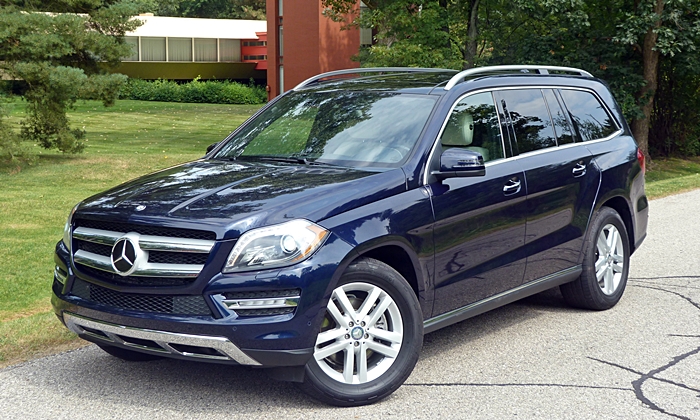
Square forms leave no doubt this is an SUV. Redesign added fender bulges, bolder grille. more GL-Class photos

Especially with the designo's quilted leather, chock full of luxury.
| |
Compared to the Q7 |
| Materials & workmanship |
 Better
Worse
Better
Worse
|
Optioned all the way from a $63,305 base price to $90,625, the tested Mercedes-Benz GL350 BlueTEC might be considered a ringer. Many of the included options aren't even shown on mbusa.com, as they are special order. Among these: a $4,800 "designo" package covers nearly the entire interior in leather, much of it quilted. Except the headliner. It's merely the sort of synthetic suede that as a standalone option can cost over $1,000. While $4,800 might seem steep, these materials take the interior ambiance to a level less expensive vehicles--even an Audi Q7 with the options available in North America--simply don't approach.
Aside from the sumptuous designo bits, the second-generation GL-Class's interior is a good step or two up from the original's. The doors close with a reassuring ka-whoomph. To start the engine, you press a large metal button. Virtually everything looks and feels solid--and worthy of this loaded GL350's lofty price. In the current Mercedes fashion, even the details have details. You're clearly not in an Acura, much less a Hyundai. The Audi's interior design is cleaner, and most arbiters of good taste would find it more tasteful. But it doesn't scream money the way the GL's does.
| Rear seat room & comfort |
 Better
Worse
Better
Worse
|
The Mercedes-Benz GL-Class is just a little longer than the Audi Q7 (201.6 vs. 200.3 inches), and isn't as wide (76.4 vs. 78.1 inches). But the Mercedes is considerably taller (72.8 vs. 68.4 inches) and not nearly as curvy. Which might explain how it is far roomier than the much sleeker Audi. Combined legroom for all three rows is 107.6 inches in the Q7 vs. 113.8 inches in the GL-Class, a large difference.
The Q7's space deficit grows the farther back you sit. For adults to even fit in the Audi's third row without extreme discomfort, those in the second row must slide their seats forward to the point that they are themselves short on knee room. While the new GL350's third row sits too low to provide thigh support, it's not nearly as cramped.
Further evidence that Audi didn't intend the Q7's third row for frequent use: the second-row seat doesn't do a good job of getting out of the way, making the path in and out of the way-back perhaps the tightest I've experienced. The second-row seat in the GL-Class tips forward to open up a much wider path. If manually tipping the seat is too much of a chore (perhaps because you'e a five-year-old and haven't yet learned to read this), $400 buys a power assist. But even with this option the seat must be manually returned to its upright position, so the point eludes me.
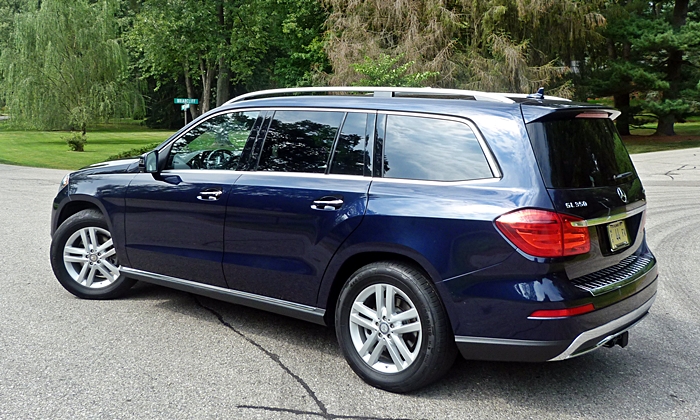
Nicely executed interaction among the side window outline, fender bulge, and tail lamp.
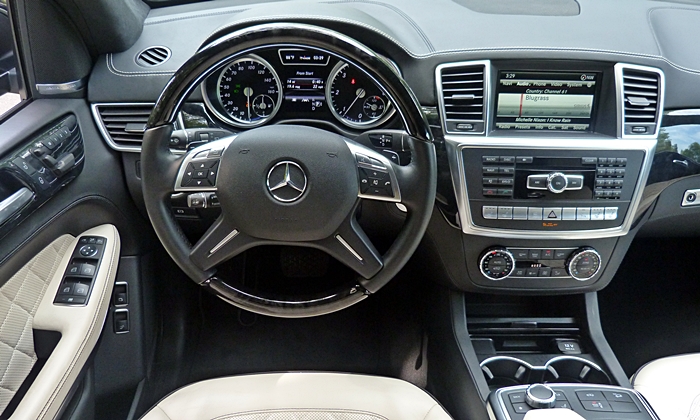
Even with COMAND, plenty of non-virtual buttons, but they're well-organized. COMAND, not so much.
| Front seat support & comfort |
 Better
Worse
Better
Worse
|
I haven't often been a fan of seat comfort in Mercedes. Well, the $1,100 multi-contour front seats aren't your typical Mercedes-Benz park benches. Though the seat bottoms still felt a bit unforgiving towards the end of a 300-mile drive, the seat backs never stopped feeling cushy, yet not at all mushy.
Want the seat to hug you tightly? The side bolsters of the multi-contour seats can be adjusted way in. The adjustable thigh support has less evident impact. But what really made our one-day trip to Chicago and back (nearly 600 miles) a joy were the built-in massagers. You can choose from four settings: slow and gentle, slow and vigorous, fast and gentle, fast and vigorous. The massagers are on a timer, so you must periodically tap-and-bump the knob for the COMAND interface to reset them.
Also want three levels each of ventilation in the front seats, to go with the standard three levels of heating? Just check another box, and hand over another $570. The second-row seat can be heated for $620. Our kids would gladly have us pay it.
| Fuel economy |
 Better
Worse
Better
Worse
|
In the EPA's fuel economy tests the Mercedes-Benz GL350 BlueTEC rates 19 mpg city and 26 mpg highway. We observed low 20s in casual suburban driving (a few mpg lower with a heavy foot, a few mpg higher with a very light one) and 25.5 on our trip to Chicago and back (which included some heavy urban driving and 70-mph highways).
These numbers don't seem so great, given that the GL350 burns diesel? Consider that the GL-Class is not only wide and tall but also very heavy, at nearly 5,500 pounds unloaded. The gas-powered GL450 is rated 14/19. Our family vehicle, a Ford Taurus X that weighs over 1,000 pounds less than the Mercedes, struggles to crack 22 on the highway. The Audi Q7 rates the same in city driving, and a couple mpg better on the highway. Since the GL350 is almost in another class size-wise, I'm calling this one a draw.
Multiply this fuel economy by a 26.4-gallon tank, and the GL350 can go quite far between $100+ fill-ups. Is it really possible to drive the nearly 300 miles to Chicago--and then back--on one tank? Yes it is, with nearly a quarter-tank to spare. (Is it possible to do this without any of three kids needing to stop for a bathroom break? To our even greater surprise, yes to this as well. They were busy watching the $1,950 dual-screen entertainment system.)
| Feature availability |
 Better
Worse
Better
Worse
|
If you can get a feature on any car, you can probably get it on a Mercedes-Benz GL-Class. I've already mentioned the designo interior and the seat features. A $1,090 panoramic sunroof covers the first two rows, while another piece of glass covers the third row.
Safety features include a drowsiness monitor, blind sport warning and intervention, lane departure warning and intervention, and all-speed adaptive cruise control with forward collision alert. Toward the end of our long one-day trip I did start to get a little tired, and these systems effectively kept me on my toes.
But my favorite feature was the most sophisticated camera system I've yet encountered. Not only does it integrate images from multiple cameras to provide a top-down view of the car and the area around it, but it adds yellow lines to indicate your path. Using this system I perfectly parked the GL350 in spaces that my eyes told me it could not get into. On the first try. The cameras are packaged with a system that will park the GL350 for you, but the top-down view works so well that I never felt inclined to check out this system.
Load up both the Mercedes-Benz and the Audi, and the former includes over $3,000 worth of features you can't get on the latter (at least not until it is redesigned for the 2015 model year).
| |
Compared to the Q7 |
| Price or payments |
 Better
Worse
Better
Worse
|
The #1 reason not to buy a Mercedes-Benz GL350 BlueTEC? This one's obvious: it's quite pricey. Even if we remove the options not offered on the Audi, the GL350 lists for over $10,000 more than the Q7, $83,910 vs. $73,645 (2014 model year prices).
As recently noted, the Mercedes-Benz does pack in more features. Adjust for these using TrueDelta's default values, and the GL350 is still about $6,800 more. And if you're willing to step down to, say, an Infiniti JX35 (QX60 for 2014)? The posh Nissan will cost you over $23,000 less before adjusting for feature differences, and still over $19,000 less afterwards (the 2014 QX60 is $300 more than the 2013 JX35). The Infiniti doesn't have a diesel, but owing to its lesser mass and CVT manages to be nearly as fuel efficient as the GL350. For even better fuel economy, a QX60 Hybrid is just around the corner.
| Ride smoothness |
 Better
Worse
Better
Worse
|
The Mercedes-Benz GL-Class has a standard air suspension. (With at least the 2007s and 2008s--we don't have reliability stats for more recent years--this suspension has been a major source of problems.) Special order suspension options include adaptive dampers that vary their firmness based on the road surface and cornering loads ($800) and active stabilizer bars that employ motors to couteract roll in turns ($2,900). The tested GL350 BlueTEC was fitted with both options, yet still rode less smoothly and less quietly than an Audi Q7 without that model's optional air springs and adaptive dampers ($2,600). Even with its standard 19-inch wheels (20s and 21s are optional), the GL350 rumbles across patchy pavement, seeking to pound the road into submission. In comfort mode, the vehicle can feel a little wobbly. In sport mode, body motions are more tightly controlled, but the ride becomes more jittery and the tires pound more firmly across bumps and divots. Still far from uncomfortable, but even on steel springs and 20s (an $800 option) the Audi feels smoother and more stable. Blame might be due the GL350's taller body and higher center of gravity.
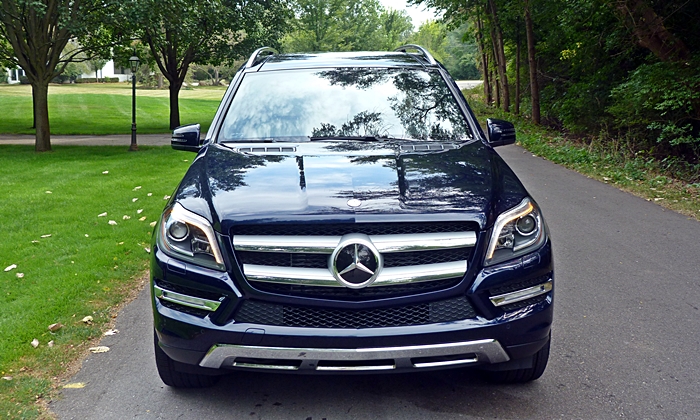
Everyone recognizes this face.
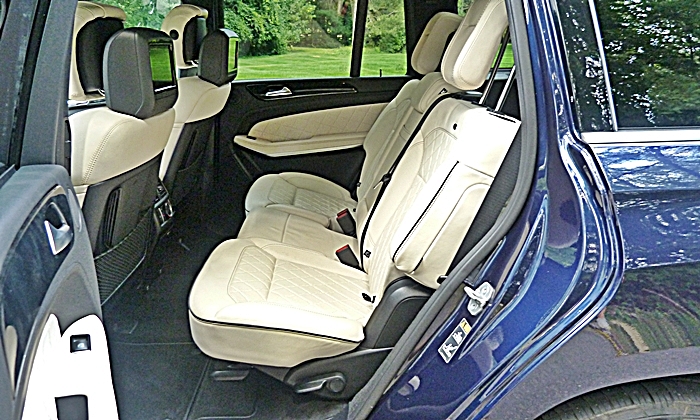
High and cushy, about as comfortable a second row as you'll find in an SUV.
| Handling |
 Better
Worse
Better
Worse
|
Plus the Audi's underlying platform was developed by Porsche.
At least when fitted with $3,700 in additional upgrades, the 2013 Mercedes-Benz GL-Class handles well for such a tall, heavy vehicle. Gayla, who not so long ago found the far smaller and lighter Hyundai Tucson too large for her taste, enjoyed driving the GL350 BlueTEC far too much for my taste ($90,000 vehicles aren't within our budget).
I had more of an issue with the GL350's handling, but not due to the inherent competence of the chassis. Pitch the GL350 into a curve with anything resembling speed, and the stability control system cuts engine power while selectively applying the brakes to induce heavy understeer. This system's threshhold is shockingly far below the safe limits of the suspension and the tires. Kudos to the active stabilizer bars for their ability to dramatically contain body roll, but what's the point given the killjoy electronic safeguards? A button to turn off (or at least dial back) the stability control system seems to only affect the traction control system (which prevents tire spin owing to acceleration).
Compared to the GL350, the Q7 handles with the composure and agility of a sport sedan. My initial thought was, "Of course it does, it's much smaller and lighter." Then I checked the spec sheets. Though not as tall, the Audi actually weighs a little more than the hulking Mercedes. How is this possible? Well, it shares a platform with the over-engineered first-generation Porsche Cayenne. The second-generation Cayenne weighs much less than the original, and the same will likely be the case with the second-generation Q7 when it arrives in 2016. As it is, I'm amazed that a 5,600-pound drives like a 4,400-pound vehicle.
Venture off the pavement (we did not), and the gas-powered GL-Class retains an edge over the Audi. Both the GL450 and GL550 can be special-ordered with an off-road package that includes a driving mode selector, a two-speed transfer case,and an enhanced air suspension that can raise the vehicle to provide a full foot of ground clearance. The option is not available with the GL350 BlueTEC, though.
| Controls and instruments |
 Better
Worse
Better
Worse
|
Nearly every current German luxury vehicle relies on a knob-controlled display to manage all but the most basic functions. Compared to BMW's iDrive and Audi's MMI, Mercedes-Benz's COMAND involves more clicks and a steeper learning curve. Though I've now spent a few weeks in various Mercedes with the latest COMAND system, much of it remains far from intuitive. The basic layout--main menu at the top of the screen, secondary menu two knob taps away at the bottom of the screen, the control screens between them--is simple enough. But navigating within some screens and even calling up the menus continued to involve an unhealthy amount of trial-and-error. Once while knocking the knob about in search of the main menu I managed to eject a CD instead.
This said, all three systems are quicker and easier to use than in the past. Compared to the GL350's price, COMAND isn't much of a barrier to ownership.
| Exterior styling |
 Better
Worse
Better
Worse
|
This one is subjective. My eyes prefer the sleek ovoid Audi to the chunky Mercedes-Benz. A bulge stamped into the rear fender works just a bit better on the GL-Class than on the 2010-2013 E-Class. The only artfully executed detail: a slight kick-up in the beltline just ahead of the rear pillar.
But anyone seeking an SUV that looks like an SUV will much prefer the Mercedes.
| |
Compared to the Q7 |
| Cargo capacity |
 Better
Worse
Better
Worse
|
You'll also find considerably more space for cargo inside the Mercedes-Benz GL-Class than inside the Audi. While 16 cubic feet behind the third row this still isn't enough for a road-tripping family, it's more than the 11 cubic feet behind the third row in the Q7. (To be fair, most if not all of the extra five cubes in the Benz is above the tops of the seats, and thus of limited use.) Fold both rows of seats (a power-folding third-row is standard in the Benz), and the GL-Class can swallow 93.8 cubic feet, vs. a Honda CR-V-like 72.5 in the Audi.
Apparently eggs aren't very space-efficient.
I didn't include cargo capacity among the reasons to buy a GL-Class because some large GM and Ford crossovers have more space inside, especially behind the third row. Minivans are even more practical. And large SUVs from GM and Ford have the most cargo space of all, with 43 cubic feet behind the third row of a Ford Expedition EL.
| Powertrain performance |
 Better
Worse
Better
Worse
|
The Mercedes-Benz GL350 BlueTEC's turbocharged 3.0-liter V6 diesel quickly dispells any concerns about the ability of a 240-horsepower engine to motivate a 5,500-pound vehicle. This diesel not only moves the big, heavy box with ease, but feels well-suited to the task. The engine only sounds like a diesel at idle and very low speeds, and not enough that many people will notice even then.
Call for brisk acceleration, and the turbodiesel engine gets louder, but the sound it makes adds to rather than detracts from the experience. The V6 sounds like a sophisticated, high-performance engine, not anything you might find under the hood of a Kenworth. Though a mere 3.0 liters, it never seems strained in the slightest, and can get the GL350 to 60 mph in about eight seconds. The gas-powered 363-horsepower GL450 cuts that to about six, and the 429-horsepower GL550 and 550-horsepower GL63AMG are quicker still. But how quick does this sort of vehicle have to be?
When not called upon for runs to its 4,300-rpm red line (because of their heavier parts, diesels can't rev as high as gas engines), the 240-horse powerplant feels at least as powerful as the GL450. How might this be? Well, diesels are especially strong at the low and moderate engine speeds typical of around-town driving. In this case, 455 lb-ft of torque are on tap at just 1,600 rpm, and you feel the shove of every one of them in your lower back. The turbocharged 4.7-liter V8 in the GL450? A mere 406 lb-ft, though at a similarly low 1,500 rpm. (The difference between horsepower and torque: torque is the amount of force per engine revolution, while horsepower is this force multiplied by the number of engine revolutions, divided by a constant.)
The Q7 TDI's diesel engine, which also has a peak output of 240 horsepower, doesn't feel as torquey as that in the Mercedes. I initially thought the difference might be perceived rather than actual, because the Audi's engine is even quieter. But the spec sheets report a nearly 50 lb-ft difference in favor of the Mercedes.
The GL350's powertrain is not flawless. When starting off from a dead stop the engine can take a moment to respond, at least partly owing to boost lag. Once I started to turn onto a busy street, but with no immediate response from the engine and oncoming cars I aborted the attempt. The gas engines respond more immediately.
Depending on your priorities, the Mercedes-Benz GL350 BlueTEC could be your ideal family hauler. Its ride and handling aren't as polished or as car-like as the Audi Q7's, but it's much roomier, offers more features and, especially with the desingo package, coddles the entire family with more luxury. The turbodiesel engine delivers plenty of shove in daily driving and far better fuel economy than the GL350's gas-powered brethren.
The problem, no surprise, is price. The GL350 costs much more than the Audi Q7, and the Audi isn't cheap. You might get what you pay for, but you'll be paying a lot.
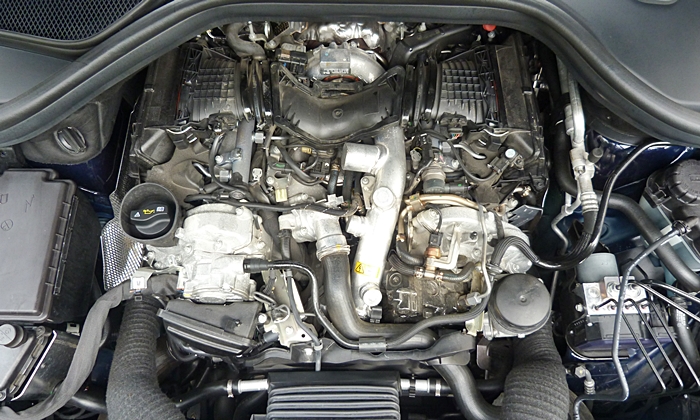
Apt FB comment: "Looks like someone dumped a wheelbarrow full of parts in the engine compartment!"
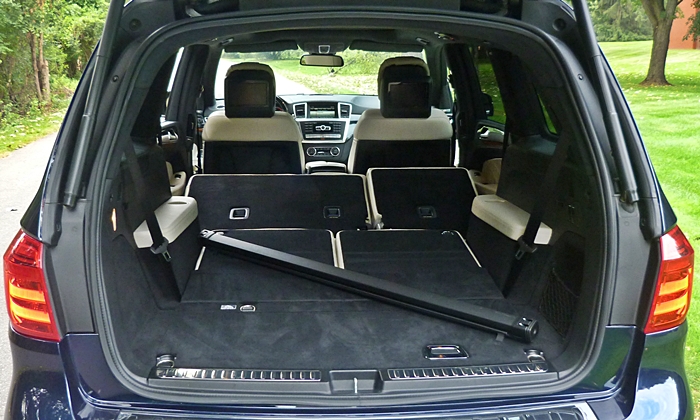
High load floor, but nearly flat and competitive in volume with large crossovers, if not minivans.
See more 2013 Mercedes-Benz GL-Class photos
Mercedes-Benz provided an insured GL350 for a week with a tank of gas. Ahmed Shaban of Fred Lavery Audi in Birmingham, MI, provided a Q7 test drive. Ahmed can be reached at 248-645-5930.











